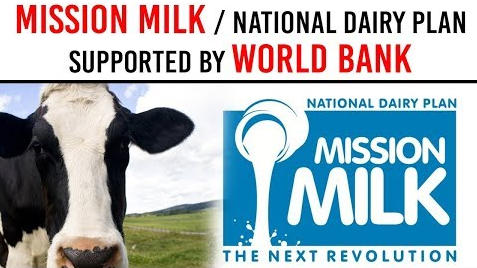Table of Contents
Q) Recently government has started working towards saving the Ongole cattle breed. This breed belongs to which state in India?
- A) Uttar Pradesh
- B) Maharashtra
- C) Haryana
- D) Andhra Pradesh
WHY IN NEWS?
- World bank is assisting National Dairy Plan- 1.
- It is being implemented by Department of Animal Husbandry and Dairying.
- It comes under the newly created Ministry of Fisheries, Animal Husbandry & Dairying.

NATIONAL DAIRY PLAN- 1
- It was started in 2012 for a period of six years from 2011-12 to 2016-17.
- But in 2017 it was extended till 2019.
- It is a central sector scheme.
- NDP I will focus on 18 major milk producing states namely Andhra Pradesh, Bihar, Gujarat, Haryana, Karnataka, Kerala, etc.
- Together they account for over 90% of the country’s milk production.
- Total investment ₹ 2242 crore ₹ 1584 crore as International Development Association (IDA) line of credit. ₹ 658 crore as Government of India share.
MAIN OBJECTIVE
- To help increase productivity of milch animals and thereby increase milk production to meet the rapidly growing demand for milk.
- To help provide rural milk producers with greater access to the organised milk-processing sector.
WHERE INDIA STANDS IN MILK PRODUCTION?
- India ranks first among the world’s milk producing Nations since 1998.
- It has the largest bovine population in the World.
- Growth rate of 6.62% from 2017 to 18.
- The per capita availability of milk in India during 2017-18 was 375 gm/day as against world’s average of 313 gm.
SIGNIFICANCE OF COW
- India has cow-based rural economy.
- Panchgavya — milk, curd, ghee, dung and urine — is a part of daily life.
- Medicinal significance of A2 milk produced by indigenous cows. It prevents disorders like obesity, arthritis, type 1 diabetes among children, autism, etc.
- Two US patents on cow urine have been granted for its medicinal properties, particularly as a bioenhancer and as an antibiotic, antifungal and anticancer agent.

RASHTRIYA GOKUL MISSION
- Launched in 2014.
- It is a project under National Programme for Bovine Breeding and Dairy Development.
- For conservation and development of indigenous breeds in a focused and scientific manner.

- The mission also envisages to develop “Gokul Grams” for development of indigenous breeds.
- As on date, 4 Gokul grams (Varanasi, Mathura, Patiala and Phora) have been completed and work is under progress in remaining 17 gokul grams.



NATIONAL KAMDHENU BREEDING CENTRE
- Under RGM, two “National Kamdhenu Breeding Centres” (NKBC) are being established as Centres of Excellence.
- To develop and conserve Indigenous Breeds in a holistic and scientific manner.
- Conservation, promotion and development of 41 species of cattle and 13 species of animals.
DISEASES

- Cow produces less milk. Brucellosis. Foot & mouth disease.
Q) Recently government has started working towards saving the Ongole cattle breed. This breed belongs to which state in India?
A) Uttar Pradesh
B) Maharashtra
C) Haryana
D) Andhra Pradesh

Latest Burning Issues | Free PDF






















 WhatsApp
WhatsApp